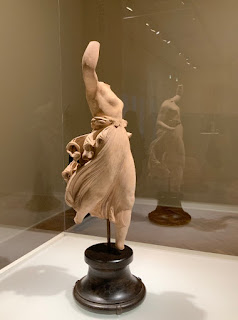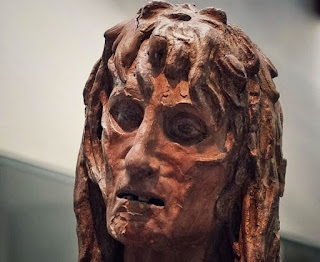A review of Canova : Sketching in Clay - at the Art institute of Chicago
Canova, Hebe, 1816
The modern aesthetic often prefers the quick sketch to the finished work in both painting and sculpture. They’re so much more spontaneous, expressive, and fresh. Many old master painters only appear in American museums for their preparatory drawings.
Chicago has yet to see a major exhibit of marbles by Antonio Canova (1757-1822) - and that's not surprising. They emphasize smoothness on the outside, emptiness on the inside, and a dryly rational organization of surrounding space as well as narrative. They were indeed appropriate for the Age of Enlightenment as well as empire . But they were anathema to the modern world that soon followed. Modern sculpture defined itself as the exact opposite. Forward looking sculptors were even expected to carve their own stone, start to finish.
A celebrity in his own time, multiple editions of Canova's designs were executed by the craftsmen in his studio. His hands touched only the clay sketches - and sometimes gave finishing touches to the marble. This exhibition offers several opportunities to see the original clay, the finished marble, and sometimes the intermediary steps as well.
The finished marbles for my favorite clay sketch (shown above) did not travel to this show, so we’ll have to go to the internet for images:
The angle of the torso is quite different - the clay piece leans back, the marble leans forward. Even more important is the inner dynamics. The clay seems to erupt from the unfurling drapery around the middle. The marble drapery just sits there in frozen perfection.
Yikes! Canova was a "modern" sculptor when he wanted to be. (Though those inner dynamics can also be found in sculpture throughout art history, beginning with the very earliest)
Turning to the front view - compare the uplift in the clay with the heaviness of the marble
( from Victoria Art Gallery, Bath )
Right: Berlin State Museum
See how drapery reveals bulging volumes beneath it in the clay, but not the marble.
Should the clay version that came to this show really be called a study ?
It was hardly dashed off in a few hours.
It's more like a finished presentation piece intended as a gift for some important person.
Canova, Humility, 1783
This one feels more sketchy -
and it's another one of my favorites.
The finished marble - a detail in the tomb of Clement XIV - is so different, there's no point in showing it. Suffice it to say - it's nowhere near as expressive
It appears even more powerful in this lighting
Canova, Madame Mere, Latizia Bonaparte, 1803-5
The portrait of Napoleon’s mother is the largest marble in the exhibition, and it’s accompanied by several sketches in clay and one intermediary plaster cast. From a distance, this view is a nightmare - the head sits so awkwardly on the torso. Up close, it’s almost as bad since every detail feels frozen, lifeless, and divorced. This looks like a funerary monument - it belongs in a crypt.
This clay sketch is much more lively- and it’s sweet as well. As gallery signage notes, it does indeed project "an air of powerful yet informal majesty". Noting the inscription on the base, this may not have served as a preparatory sketch at all - but was spun off from the project to serve as a gift..
St. Helena, Roman, Head 325 AD, Torso second century
This ancient piece is often credited as the model for Canova’s Madame Mere. How appropriate! Helena was the mother of another great emperor: Constantine.
The head was also created apart from the torso — maybe two centuries later - but it still makes for a better match . The torso attends to inner volume and displays the interaction of opposing forces that pleases the eyes and gives it life. Note, for example, how the front leg of the chair meets and continues the line of the drapery fold above it. Canova’s version ignores that possible connection.
Canova, Magdalene, (Genoa version - 1893-6)
This is the other large marble in the show. The green to pink colors in the stone feel so flesh like it’s spooky - because the form appears so cold and lifeless.
The exhibit put this piece near the floor, so viewers looked down at it. But as this online photo shows, it looks better when the chest is eye level.
Here is a beautifully lit detail from the Museo Canova.
Believe me - it looks nothing like this on the floor of Regenstein Hall.
Canova, Magdalene (Hermitage version, 1808-9)
This later copy is now in St.Petersburg.
The detail is more delicate - especially in the hair - but the power in the torso has been lost. Perhaps that reflects the changing taste of Canova - or maybe a different crew did the carving for him.
Donatello, Magdalen , 1440
We can’t blame Canova for catering to the taste of his contemporaries - he had to make a living.
But still…..
Donatello’s wood carving is on fire with spiritual intensity.
Wouldn’t you like to see what she sees?
Canova’s marble is a sweet young thing, tearing up with shame.
Wouldn’t you like to touch her soft skin?
Canova, Bust of Paris, 1809
This piece gives us a good opportunity to study Canova’s final touches to the marble surface.
It was gifted to
Quatremere de Quincy
- a distinguished art administrator and architectural theorist - so I’m guessing that Canova did the very best job he could.
Photos cannot reveal the special quality of the polished surface. It’s infused with light, and transitions are oh-so soft. It almost feels backlit - especially when compared to the flatness of the plaster casts in the show.
Canova, Nymph and Satyr, 1786
Many of the clay "sketches" really appeared to have been taken much further. This one, however, might have been mostly done in fifteen minutes. It’s a rape scene - isn’t it? Or at least one of those old school interactions where "no" really means "yes". Nowadays about as politically incorrect as Trump. But it’s so expressive - and it designs space so well - it’s often been used to promote this exhibition.





















No comments:
Post a Comment